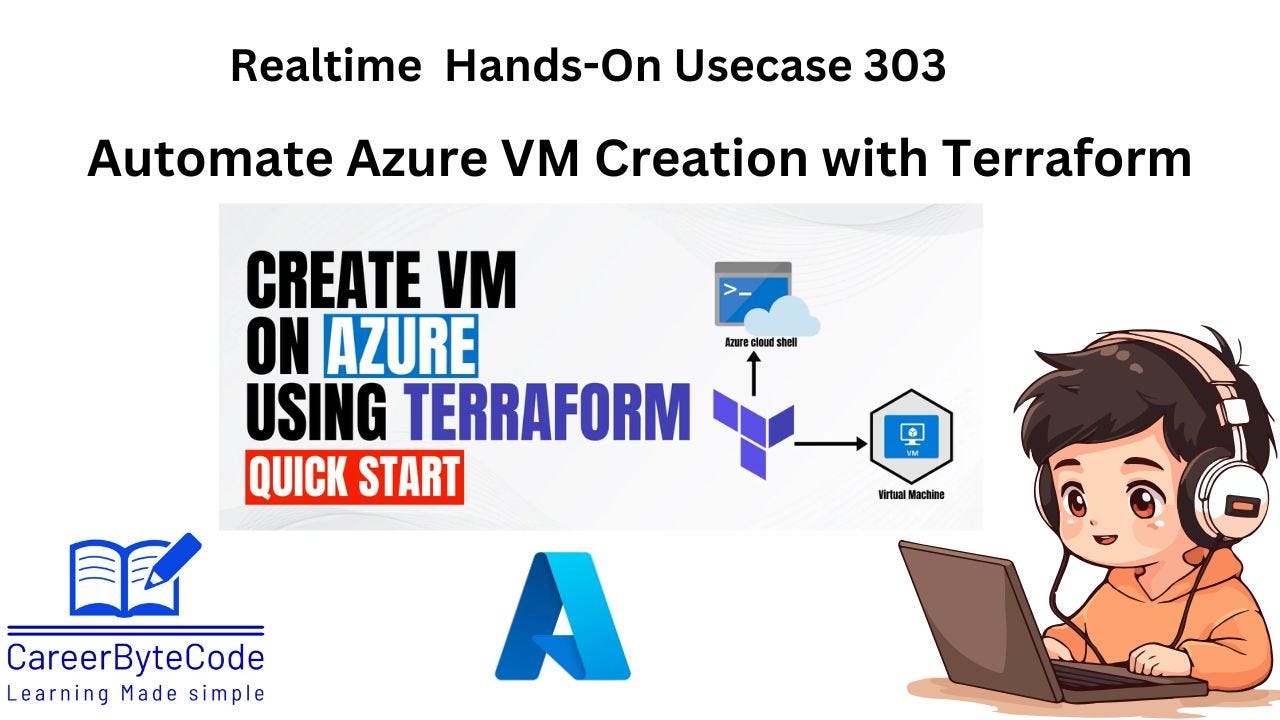Step-by-Step Guide to Creating Azure VMs with Terraform
Terraform is an Infrastructure as Code (IaC) tool that simplifies the provisioning and management of cloud resources.
1. Usecase Scenario
Objective: Use Terraform to provision Azure resources.
Steps:
Install Terraform and configure Azure CLI.
Write a Terraform script to create a resource group, storage account, and virtual machine.
Initialize Terraform and apply the configuration.
Verify the resources in the Azure portal.
Modify the script to add a second VM and reapply.
2. Why We Need This Use Case
Terraform is an Infrastructure as Code (IaC) tool that simplifies the provisioning and management of cloud resources. Using Terraform to create Azure virtual machines (VMs) provides several benefits:
Automation: Automates the creation and management of Azure resources, reducing manual effort.
Consistency: Ensures consistent infrastructure deployment across environments.
Scalability: Easily modify configurations to scale resources up or down.
Version Control: Terraform scripts can be version-controlled, enabling better collaboration and tracking of changes.
This use case is essential for organizations looking to streamline their Azure resource provisioning process and adopt DevOps practices.
The use case of creating two virtual machines (VMs) in Azure using Terraform is essential for organizations and individuals aiming to adopt Infrastructure as Code (IaC) practices. In modern IT environments, manual provisioning of cloud resources can be time-consuming, error-prone, and inconsistent. Terraform, as a declarative IaC tool, provides a solution to these challenges by enabling automated, repeatable, and scalable infrastructure deployment.This use case is particularly important because it addresses several key needs:
Automation and Efficiency: By automating the provisioning of Azure resources, Terraform eliminates the need for manual intervention, saving time and reducing human errors.
Consistency Across Environments: Terraform ensures that infrastructure is deployed consistently across development, staging, and production environments, reducing discrepancies and improving reliability.
Scalability: As businesses grow, their infrastructure needs to scale. Terraform makes it easy to modify configurations and scale resources up or down without starting from scratch.
Cost Optimization: By using Terraform scripts, organizations can track and manage their infrastructure more effectively, ensuring resources are provisioned only when needed.
Learning and Skill Development: For developers and IT professionals, this use case provides hands-on experience with Terraform and Azure, building skills that are highly valuable in the cloud computing industry.
In essence, this use case is a stepping stone for organizations and individuals looking to modernize their infrastructure management practices, adopt DevOps methodologies, and leverage the full potential of cloud computing.
3. When We Need This Use Case
When setting up a development or production environment in Azure.
To automate the provisioning of multiple VMs for testing or deployment.
When managing infrastructure as code to ensure consistency and repeatability.
To quickly scale resources by adding or modifying VMs in Azure.
For learning and practicing Terraform with Azure.
This use case is applicable in a variety of scenarios where automation, scalability, and consistency are critical. Some specific situations include:
Setting Up Development or Testing Environments: When developers need isolated environments for testing applications, Terraform can quickly provision the required VMs and associated resources.
Deploying Production Workloads: For production environments, Terraform ensures that infrastructure is deployed consistently and adheres to predefined configurations, reducing the risk of errors.
Scaling Infrastructure: When an organization needs to add more VMs to handle increased workloads, Terraform simplifies the process by allowing modifications to the existing script.
Disaster Recovery and Backup: In disaster recovery scenarios, Terraform scripts can be used to quickly recreate infrastructure in a different region or availability zone.
Learning and Experimentation: For IT professionals and students, this use case provides a practical way to learn Terraform and Azure, enabling them to experiment with cloud infrastructure in a controlled manner.
Adopting DevOps Practices: Organizations transitioning to DevOps can use Terraform to integrate infrastructure provisioning into their CI/CD pipelines, ensuring seamless deployment and management of resources.
This use case is particularly valuable for businesses that rely on cloud infrastructure for their operations, as it provides a reliable and efficient way to manage resources while reducing operational overhead.
4. Challenge Questions for This Use Case
Keep reading with a 7-day free trial
Subscribe to CareerByteCode’s Substack to keep reading this post and get 7 days of free access to the full post archives.



